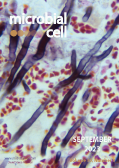Table of contents
Volume 10, Issue 9, pp. 178 - 203, September 2023
Cover: Methenamine sliver-stained lung tissue specimen, revealing numerous darkly stained filaments of an Aspergillus sp. fungal organism, in a case of aspergillosis (image by the Centers for Disease Control and Prevention, USA; image modified by MIC). The cover is published under the Creative Commons Attribution (CC BY) license.
Enlarge issue cover
The coenzyme B12 precursor 5,6-dimethylbenzimidazole is a flavin antagonist in Salmonella
Lahiru Malalasekara and Jorge C. Escalante-Semerena
Research Articles |
page 178-194 | doi: 10.15698/mic2023.09.803 | Full text | PDF |
Abstract
Salmonella enterica subsp. enterica sv. Typhimurium str. LT2 (hereafter S. Typhimurium) synthesizes adenosylcobalamin (AdoCbl, CoB12) de novo only under anoxic conditions, but it can assemble the lower ligand loop (a.k.a. the nucleotide loop) and can form the unique C-Co bond present in CoB12 in the presence or absence of molecular oxygen. During studies of nucleotide loop assembly in S. Typhimurium, we noticed that the growth of this bacterium could be arrested by the lower ligand nucleobase, namely 5,6-dimethylbenzimidazole (DMB). Here we report in vitro and in vivo evidence that shows that the structural similarity of DMB to the isoalloxazine moiety of flavin cofactors causes its deleterious effect on cell growth. We studied DMB inhibition of the housekeeping flavin dehydrogenase (Fre) and three flavoenzymes that initiate the catabolism of tricarballylate, succinate or D-alanine in S. Typhimurium. Notably, while growth with tricarballylate was inhibited by 5-methyl-benzimidazole (5-Me-Bza) and DMB, growth with succinate or glycerol was arrested by DMB but not by 5-Me-Bza. Neither unsubstituted benzimidazole nor adenine inhibited growth of S. Typhimurium at DMB inhibitory concentrations. Whole genome sequencing analysis of spontaneous mutant strains that grew in the presence of inhibitory concentrations of DMB identified mutations effecting the cycA (encodes D-Ala/D-Ser transporter) and dctA (encodes dicarboxylate transporter) genes and in the coding sequence of the tricarballylate transporter (TcuC), suggesting that increased uptake of substrates relieved DMB inhibition. We discuss two possible mechanisms of inhibition by DMB.
Yeast gene KTI13 (alias DPH8) operates in the initiation step of diphthamide synthesis on elongation factor 2
Meike Arend, Koray Ütkür, Harmen Hawer, Klaus Mayer, Na-mit Ranjan, Lorenz Adrian, Ulrich Brinkmann and Raffael Schaffrath
Research Reports |
page 195-203 | doi: 10.15698/mic2023.09.804 | Full text | PDF |
Abstract
In yeast, Elongator-dependent tRNA modifications are regulated by the Kti11•Kti13 dimer and hijacked for cell killing by zymocin, a tRNase ribotoxin. Kti11 (alias Dph3) also controls modification of elongation factor 2 (EF2) with diphthamide, the target for lethal ADP-ribosylation by diphtheria toxin (DT). Diphthamide formation on EF2 involves four biosynthetic steps encoded by the DPH1-DPH7 network and an ill-defined KTI13 function. On further examining the latter gene in yeast, we found that kti13Δ null-mutants maintain unmodified EF2 able to escape ADP-ribosylation by DT and to survive EF2 inhibition by sordarin, a diphthamide-dependent antifungal. Consistently, mass spectrometry shows kti13Δ cells are blocked in proper formation of amino-carboxyl-propyl-EF2, the first diphthamide pathway intermediate. Thus, apart from their common function in tRNA modification, both Kti11/Dph3 and Kti13 share roles in the initiation step of EF2 modification. We suggest an alias KTI13/DPH8 nomenclature indicating dual-functionality analogous to KTI11/DPH3.










